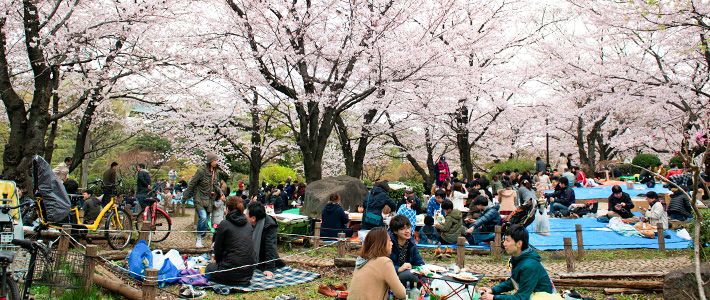
“Hanami” 101: Staking Out a Blossom Viewing Spot
Society Culture- English
- 日本語
- 简体字
- 繁體字
- Français
- Español
- العربية
- Русский
The season for viewing cherry blossoms is surprisingly long in Japan, beginning as early as January in Okinawa and other southern islands and lasting through May in northern Hokkaido. In each location, though, the prime viewing period is short, making it a challenge to set up a time to picnic under the flowering trees that aligns with both nice weather and a day off from work or school.
The brevity of the season is summed up in the Japanese saying Sakura wa nanoka (cherry blossoms last but seven days). With such a narrow window to enjoy the ancient custom of hanami, or flower viewing, people flock en masse to parks and other venues to feast with family, friends, or colleagues under the short-lived blossoms.
The practice, while poetic in spirit, presents practical headaches in Japan’s densely populated urban environment. Local authorities often take special measures to prepare for the onrush of sakura viewing, including posting notices and setting up temporary garbage collection points and portable toilets at popular locations.
Celebrants face the daunting task of claiming space under the pink blossoms, a monumental logistic challenge during peak weekend viewing. Known as bashotori, the art of finding a prime swath of comfortable and solid ground comes down to knowledge, skill, and luck. Securing a place with a good view of the trees is praiseworthy, and ensuring everyone has plenty of space to converse comfortably is impressive. But locking down an area that is also within easy walking distance of a toilet is close to miraculous.
 Hanami revelers eat and drink under the blossoms.
Hanami revelers eat and drink under the blossoms.
The Ins and Outs of Bashotori
Patience is key to sequestering an ideal location. In April Nippon.com staff answered the call of the sakura and visited the banks of the Sumida River near Asakusa, one of Tokyo’s preeminent hanami spots. By the time our group arrived at around 10:30 am, almost every square inch of suitable space was taken up with blue tarps (the typical “floor” put down for flower viewing), picnic mats, and in one instance a large table made out of cardboard boxes.
Each group admitted having members who had been at the park since 6:00 or 7:00 in the morning, and some even earlier. There were also lone guardians keeping patient watch over vast, empty mats as well as vacant tarps marked simply by a surname or company name scrawled on duct tape.
This latter practice of proxy bashotori is universally frowned upon, but it lingers on nonetheless. In a recent incident, a Yokohama-based corporation provoked a social media maelstrom by laying claim to a 500-square-meter plot in Kamonyama Park, a popular flower viewing locale in the city.
Pictures of huge blue tarps marked with the times and dates the company would be using the space attracted heavy criticism as they made their way around the Internet—the company showed some consideration by welcoming other celebrants to utilize the space outside set times.
Rite of Passage
April, the start of the fiscal year in Japan, is when many companies welcome fresh recruits. It is said that bashotori is the first great responsibility of these rookies, but while this might have been a common practice in the past, it appears to have waned in the present day. A survey of 287 young subscribers to the news website Mynavi News revealed that only 1.1% of respondents had been given the task of securing a hanami spot when joining their company, while 89.5% answered it was not a mandatory chore. A further 9.4% said it depended on circumstances.
Regardless, the image persists. Some career-related websites in Japan even offer up tips for securing premium hanami spots that include spending the night at a place, working in pairs, and never leaving an area unattended. The April 7 edition of popular Asahi Shimbun column “Tenseijingo” advised employees charged with bashotori to bring plenty of cardboard, along with a smartphone or something to read to ease the long, cold hours of waiting.
 A tarp, a cardboard table, and newspapers serve as a makeshift hanami spot.
A tarp, a cardboard table, and newspapers serve as a makeshift hanami spot.
Sake and Sakura
Another saying associated with flower viewing rhetorically asks in Japanese, “What would be cherry blossoms without sake?” Sake and sakura have long been companions in Japanese poetry, literature, and art. Nowadays the term sake includes libations of all kinds, not only the traditional Japanese tipple.
This association was duly apparent under the trees along the Sumida River. Regardless of generational makeup, all the hanami groups included alcoholic beverages as a central element of their spreads. Throughout the park large bottles of sake and crates of beer sat in anticipation of the opening toast. Beverage companies join in the spirit by offering products in attractive pink cans decorated with spring and cherry blossom motifs.
Although alcohol is best enjoyed in moderation, it is easy to get carried away in celebrating the blossoms. According to some reports, over the two weeks of Tokyo’s hanami season emergency crews responded to 104 cases of alcohol poisoning in parks, with nearly 18 people being hospitalized.
On the whole, though, revelers observe a few basic rules, including knowing one’s limit and not getting too carried away in the spirit of celebration. For most people flower viewing represents an opportunity to let down their hair, enjoy a meal with friends and colleagues out in the open, and gaze up at the gentle rain of petals fluttering down from the sakura onto their little spot under the cherry trees.
(Originally written in Spanish by Daniel Rubio of Nippon.com. Banner photo: People enjoy flower viewing at a Tokyo park. Photographs by Kodera Kei.)